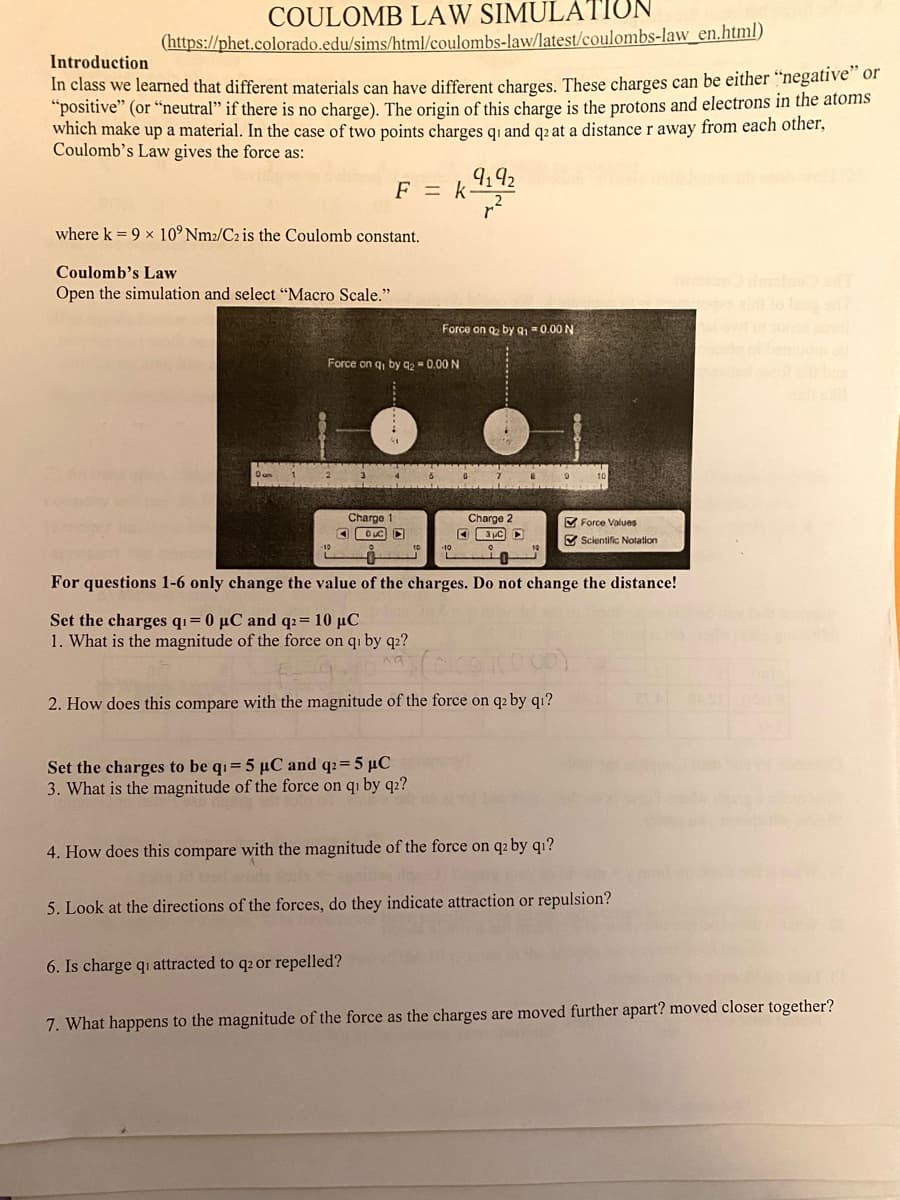Set the charges to be qi= 5 µC and q=5 µC 3. What is the magnitude of the force on qi by q2? 4. How does this compare with the magnitude of the force on q2 by qı?
Set the charges to be qi= 5 µC and q=5 µC 3. What is the magnitude of the force on qi by q2? 4. How does this compare with the magnitude of the force on q2 by qı?
Chapter7: Electricity
Section: Chapter Questions
Problem 7Q
Related questions
Question
please use this website for reference
https://phet.colorado.edu/sims/html/coulombs-law/latest/coulombs-law_en.html
or search “phet colorado coulomb’s law law”
afterwards click macro scale
to answer questions
DO ONLY questions 3 & 4 please

Transcribed Image Text:COULOMB LAW SIMULATION
(https://phet.colorado.edu/sims/html/coulombs-law/latest/coulombs-law_en.html)
Introduction
In class we learned that different materials can have different charges. These charges can be either "negative of
"positive" (or “neutral" if there is no charge). The origin of this charge is the protons and electrons in the atoms
which make up a material. In the case of two points charges qi and q2 at a distance r away from each other,
Coulomb's Law gives the force as:
F = k9192
where k = 9 x 10° Nm2/C2 is the Coulomb constant.
Coulomb's Law
Open the simulation and select "Macro Scale."
Force on q, by 91 =0.00 N
Force on q, by 92 = 0.00 N
Charge 1
Charge
M Force Values
Scientific Notation
For questions 1-6 only change the value of the charges. Do not change the distance!
Set the charges qi= 0 µC and q2= 10 µC
1. What is the magnitude of the force on qi by q2?
2. How does this compare with the magnitude of the force on q2 by q1?
Set the charges to be qi= 5 µC and q2=5 µC
3. What is the magnitude of the force on qi by q2?
4. How does this compare with the magnitude of the force on q2 by qı?
5. Look at the directions of the forces, do they indicate attraction or repulsion?
6. Is charge qi attracted to q2 or repelled?
7. What happens to the magnitude of the force as the charges are moved further apart? moved closer together?
Expert Solution
This question has been solved!
Explore an expertly crafted, step-by-step solution for a thorough understanding of key concepts.
Step by step
Solved in 3 steps with 3 images

Knowledge Booster
Learn more about
Need a deep-dive on the concept behind this application? Look no further. Learn more about this topic, physics and related others by exploring similar questions and additional content below.Recommended textbooks for you


Physics for Scientists and Engineers: Foundations…
Physics
ISBN:
9781133939146
Author:
Katz, Debora M.
Publisher:
Cengage Learning

College Physics
Physics
ISBN:
9781938168000
Author:
Paul Peter Urone, Roger Hinrichs
Publisher:
OpenStax College


Physics for Scientists and Engineers: Foundations…
Physics
ISBN:
9781133939146
Author:
Katz, Debora M.
Publisher:
Cengage Learning

College Physics
Physics
ISBN:
9781938168000
Author:
Paul Peter Urone, Roger Hinrichs
Publisher:
OpenStax College

Glencoe Physics: Principles and Problems, Student…
Physics
ISBN:
9780078807213
Author:
Paul W. Zitzewitz
Publisher:
Glencoe/McGraw-Hill